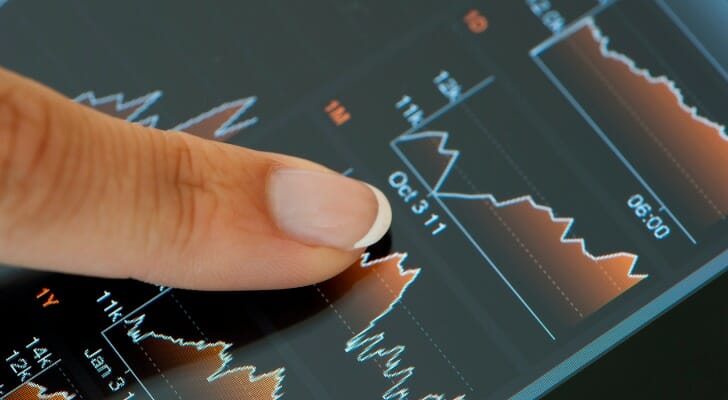 You get in the shower and turn on the hot tap. The water’s cold, so you turn the tap a little further. Still nothing, so you give it another nudge. Then, all that hot water bursts out at once. You let out an undignified yelp and jump backward, suddenly understanding how a stock market bubble bursts and a Great Recession begins.
You get in the shower and turn on the hot tap. The water’s cold, so you turn the tap a little further. Still nothing, so you give it another nudge. Then, all that hot water bursts out at once. You let out an undignified yelp and jump backward, suddenly understanding how a stock market bubble bursts and a Great Recession begins.
What Is a Stock Market Bubble?
A stock market bubble is a period of growth in stock prices followed by a fall. Typically prices rise quickly and significantly, growing far beyond their previous value in a short period of time. When they fall, they do so quickly and often below the starting value.
A stock market bubble can affect either the market as a whole or a specific sector, such as within individual industries or geographic regions. They typically occur when investors overvalue stocks, either misjudging the value of the underlying companies or trading based on criteria unrelated to that value.
For example, a stock market bubble often forms when traders enter a self-sustaining cycle of growth. As people buy certain stocks, they drive the prices of those stocks up. Other traders may see that growth and buy as well, hoping to profit from the gains. Eventually, traders aren’t buying the given stocks because they think the company is worth owning at that price. They’re buying in hopes of selling while the price is still high.
This leads to a cycle of trading based on criteria that has nothing to do with the fundamentals of the companies being traded. If this cycle goes on too long it can profoundly overvalue the underlying assets, creating a stock market bubble that will eventually burst.
The Dot Com Bubble
 Back in 2002, the dot-com bubble burst. During the late 1990’s it seemed like any company with a dot-com at the end of its name could find a firehose of money from eager investors. Companies such as the infamous Pets.com received high capitalization and strong initial public offerings.
Back in 2002, the dot-com bubble burst. During the late 1990’s it seemed like any company with a dot-com at the end of its name could find a firehose of money from eager investors. Companies such as the infamous Pets.com received high capitalization and strong initial public offerings.
However, these companies typically traded based on little more than enthusiasm. Most did not have sound business models and were burning through investor cash with no significant chance of returns. Investors on the stock market traded these assets eagerly for a while, each hoping for the gains that would come from selling the stock at a higher price.
Eventually, the quality of the underlying businesses caught up with these stocks. Investors began to sell, leading others to sell as well. Without the promise of growth, investors had no reason to hold on to these stocks. The stock market bubble burst and prices began to tumble.
It is a history lesson that many investors should consider carefully in the era of app-based initial public offerings (IPOs), many of which resemble their predecessors from 20 years ago.
Positive/Negative Feedback Loops
A stock market bubble is typically characterized by what economists call positive and negative feedback loops.
In a positive feedback loop, whatever has begun to push stock prices up becomes self-sustaining. The example of investors chasing higher growth is a good one. As prices go up, investors can sell their stocks for more money. Other investors want to capitalize on this growth and buy those stocks, pushing the prices up higher and causing still more investors to chase those profits. The cycle feeds on itself.
When a positive feedback loop is based on a fundamental truth or underlying reality, this is typically a good thing. For example, when the underlying businesses are getting stronger, a positive feedback loop will simply reflect reality. Arguably, the entire modern history of the stock market is a positive feedback loop marked by periods of short-term volatility.
However, when this loop is based on false information or changeable incentives it can be very easy to break. This is what happened during the Stock Market Crash of 1929.
Negative Feedback Loops and Bubbles
In the 1920s investors engaged heavily in a practice called “speculation.” This is when an investor will buy stocks with borrowed money, planning to pay off the loan with the profits. When speculation works it can make someone a millionaire overnight. When it fails it can leave them with impossible amounts of debt.
Many factors played into the stock market crash of 1929, but speculation was a key part of it. Trading no longer became about capitalizing on gains with borrowed money. It became about mitigating losses on debts the traders couldn’t afford to pay.
So investors began to sell, hoping to limit their debts. This pushed the prices of stocks down, leading other investors to quickly sell hoping to limit their own losses. This pushed prices down further, bringing in more traders still and creating what is known as a “negative feedback loop.”
In a negative feedback loop, poor economic conditions feed upon themselves and create a self-sustaining pattern of contraction. This is typically what happens when a stock market bubble bursts. Investors sell their stocks, which pushes down prices, leading more investors to sell in hopes of mitigating their losses.
Bubbles vs. Growth
 Prices going up are not the same thing as inflating a stock market bubble. Economic growth has led the stock market to gain value steadily ever since economists began keeping track. It withstood periods of losses including recessions and the Great Depression. This is not the same thing as a 200-year stock market bubble.
Prices going up are not the same thing as inflating a stock market bubble. Economic growth has led the stock market to gain value steadily ever since economists began keeping track. It withstood periods of losses including recessions and the Great Depression. This is not the same thing as a 200-year stock market bubble.
The key difference between a stock market bubble and economic growth is the series of incentives driving prices.
In the stock market, growth is marked by trading based on underlying business fundamentals. The price of a stock should approximately reflect the value of owning that particular company. Stock prices reflect not just a company’s net assets but also an investor’s best judgment about the company’s business plan, corporate leadership, position in the market and anticipated profits.
When trading is driven by these fundamentals it will typically lead prices to rise in a stable pattern that we term “growth.” A growing market will not pop like a bubble because, ultimately, the assets have inherent value. During a selloff, traders have as much incentive to hold on to their stocks as to unload them. This causes swelling to hit a natural floor and disrupts the negative feedback loop that characterizes the second stage of a stock market bubble. Bubbles are not the same thing.
The Essence of a Bubble
As discussed, when a stock market bubble forms it is because investors have bought stocks based on criteria other than the value of the underlying asset. Often this can be as simple as short-term enthusiasm. A category of investment can seem exciting, driving traders to make emotional purchases they otherwise wouldn’t. Or it relies on bad information, such as during the 2008 housing crisis when rating agencies identified subprime mortgage assets as high-quality investments.
Regardless of the reason, the essential aspect of a stock market bubble is this: The basis of that trading can go away. Enthusiasm can wane. Bad information corrects itself. Most often, people chasing ever-higher profits will see the growth falter. When that happens they no longer have any reason to hold on to their stocks. The selling begins and the stock market bubble pops.
The Bottom Line
Historically, a stock market bubble tends to pop for unpredictable reasons. A random slowdown in trading or a trader who misses delivery on a contract can cause the entire market to suddenly change. Figuring out if that will happen and how is one of the challenges of managing a successful stock market.
Ultimately, most traders can only recognize a stock market bubble in hindsight. It’s obvious after the fact when an asset was worth half of what you paid for it, less so at the time. The few investors who see them coming to get an opportunity to earn enough to make them rich, in some cases.
Stock Market Tips
- If you think a stock market bubble could wreck your investment plans, consider speaking with a financial advisor. Finding a financial advisor doesn’t have to be hard. SmartAsset’s free tool matches you with up to three vetted financial advisors who serve your area, and you can interview your advisor matches at no cost to decide which one is right for you. If you’re ready to find an advisor who can help you achieve your financial goals, get started now.
- What’s your risk tolerance in the event of a stock market bubble? Do you know how a burst bubble would affect your portfolio’s growth? SmartAsset’s investing guide can help you sort out the basic details and prepare for the worst.
Photo credit: ©iStock.com/courtneyk, ©iStock.com/katleho Seisa, ©iStock.com/Suwanmanee99